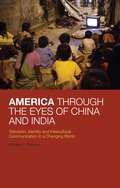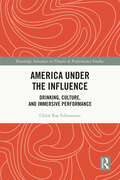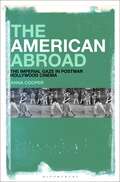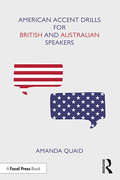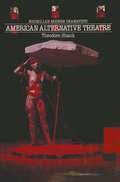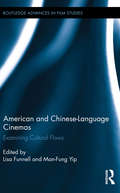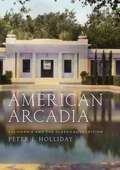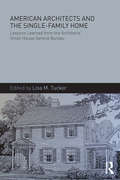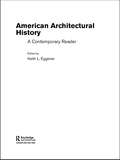- Table View
- List View
America Through the Eyes of China and India: Television, Identity, and Intercultural Communication in a Changing World
by Edward D. ShermanAmerica has long exported its network and cable programming abroad, but with a changing world comes a changing dynamic. As global centers of power shift, and wealth becomes redistributed, and perhaps even re-centered, vast audiences which have never before had contact with American television will begin to gain access to the full wealth and abundance of American programming. The opening of new markets and new audiences, particularly within the growing superpowers of China and India, presents us with a novel situation. It is one thing for a show like The OC to be played in a nation like England, where the cultural and religious differences with the United States are not that profound, and quite another for it to air in a nation like India, where arranged marriages, the caste system, and pervasive poverty are still everyday realities.America Through the Eyes of China and India explores the dynamics of television, identity, and cultural communication, providing a new lens for encountering, interpreting, and judging American culture and the American identity.
America Under the Influence: Drinking, Culture, and Immersive Performance (Routledge Advances in Theatre & Performance Studies)
by Chloë Rae EdmonsonIn this book, Chloë Rae Edmonson analyzes performance sites from throughout U.S. history to reveal the material ways that drinking culture is performative, immersive performance is intoxicating, and how alcohol shapes performance space. Combining archival research with first-hand accounts of immersive spaces, this study demonstrates how social drinking and performance in themed spaces often collude to reify power dynamics latent to mainstream American culture, such as patriarchal values, racial and wealth inequality, and labor exploitation. Yet there are also examples of how performers, designers, and consumers creatively subvert such dominant attitudes in pursuit of their own creative expression and fulfilment.Part one examines historic bars and clubs that are immersive by design, while part two explores immersive theatre productions from the 1980s to today. At the heart of all these American examples, of course, is alcohol, its associated cultures of immersive consumption, and the wide range of influence it can have on the bodies and minds of participants. In addition to its pop cultural appeal, this study will be relevant to scholars and university students interested in immersive theatre and performance, drinking culture, and American Studies.
America Under the Influence: Drinking, Culture, and Immersive Performance (Routledge Advances in Theatre & Performance Studies)
by Chloë Rae EdmonsonIn this book, Chloë Rae Edmonson analyzes performance sites from throughout U.S. history to reveal the material ways that drinking culture is performative, immersive performance is intoxicating, and how alcohol shapes performance space. Combining archival research with first-hand accounts of immersive spaces, this study demonstrates how social drinking and performance in themed spaces often collude to reify power dynamics latent to mainstream American culture, such as patriarchal values, racial and wealth inequality, and labor exploitation. Yet there are also examples of how performers, designers, and consumers creatively subvert such dominant attitudes in pursuit of their own creative expression and fulfilment.Part one examines historic bars and clubs that are immersive by design, while part two explores immersive theatre productions from the 1980s to today. At the heart of all these American examples, of course, is alcohol, its associated cultures of immersive consumption, and the wide range of influence it can have on the bodies and minds of participants. In addition to its pop cultural appeal, this study will be relevant to scholars and university students interested in immersive theatre and performance, drinking culture, and American Studies.
The American Abroad: The Imperial Gaze in Postwar Hollywood Cinema
by Anna CooperAn American Abroad reframes postcolonial film aesthetics through a close textual study of Hollywood films about European travel from the long 1950s. The heterogeneous cycle of films made from 1948 to 1964 that depict Americans traveling in contemporary Europe portray a complex and fraught cultural encounter between American hegemonic power and a Europe that is being economically, socially and culturally dominated from across the Atlantic. Dr. Anna Cooper explores how discourses of European travel – Parisian shopping trips, Roman holidays, Berlin political intrigues and so on – are harnessed in service of American domination, often positioning America as the benevolent savior of postwar Europe, although this positioning is also often problematized by various details of the films, or resisted through a European actor's performance. By exploring a mix of European locations and Hollywood genres, Cooper's study opens up a plethora of theoretical and aesthetic considerations in their approaches to the colonial text: orientalism, gaze theory, the picturesque, the sublime, the ethnographic, and theories of space/place/the urban, among others.
The American Abroad: The Imperial Gaze in Postwar Hollywood Cinema
by Anna CooperDrawing on cinema and media studies, art history, American studies, and postcolonial studies, this innovative book offers a fresh way of thinking about Hollywood film aesthetics. It explores how eighteenth- and nineteenth-century Western colonial formations of vision influenced classical Hollywood film style, and thus provides a new and unique perspective on the origins of the cinematic gaze. Classical Hollywood cinema constructs global spaces as an imaginative dreamworld,subsuming geographical and cultural differences into utopian fantasy. Yet, this characteristically Hollywoodian aesthetic has rarely been explored in detail. How are such representations constructed within film texts? Is this utopian aesthetic really as uniform and transparent as it appears? What is its relationship to the United States' status as an imperial power? In The American Abroad, Anna Cooper explores how postwar Hollywood cinema adopted elements of British and French imperial visual culture, transforming them to suit a new United Statesian context. Cooper argues that four visual discourses in particular-the sublime, the ethnographic, the picturesque, and glamour-became building blocks in the development of a new American visual language.
American Accent Drills for British and Australian Speakers
by Amanda QuaidAmerican Accent Drills for British and Australian Speakers provides a comprehensive guide to learning a "General American" accent, made specifically for native English speakers. Unlike most American accent guides, which are geared toward ESL learners, this handbook covers only the shifts that English speakers need to make – nothing more, nothing less. In addition to vowel and consonant drills, it covers the finer points of American intonation and elision, features that often elude English speakers of other dialects. Finally, it provides exercises for "owning" the dialect, finding authenticity and making it work for each individual actor in their own way. This is an excellent resource for students of speech and dialects, actors from the UK, Australia, and New Zealand, and advanced ESL learners who need to use an American accent on screen or on stage. American Accent Drills for British and Australian Speakers also includes access to downloadable audio files of the practice drills featured in the book, to help students practice and perfect their American accent.
American Accent Drills for British and Australian Speakers
by Amanda QuaidAmerican Accent Drills for British and Australian Speakers provides a comprehensive guide to learning a "General American" accent, made specifically for native English speakers. Unlike most American accent guides, which are geared toward ESL learners, this handbook covers only the shifts that English speakers need to make – nothing more, nothing less. In addition to vowel and consonant drills, it covers the finer points of American intonation and elision, features that often elude English speakers of other dialects. Finally, it provides exercises for "owning" the dialect, finding authenticity and making it work for each individual actor in their own way. This is an excellent resource for students of speech and dialects, actors from the UK, Australia, and New Zealand, and advanced ESL learners who need to use an American accent on screen or on stage. American Accent Drills for British and Australian Speakers also includes access to downloadable audio files of the practice drills featured in the book, to help students practice and perfect their American accent.
American and Chinese-Language Cinemas: Examining Cultural Flows (Routledge Advances in Film Studies)
by Lisa Funnell Man-Fung YipCritics frequently describe the influence of "America," through Hollywood and other cultural industries, as a form of cultural imperialism. This unidirectional model of interaction does not address, however, the counter-flows of Chinese-language films into the American film market or the influence of Chinese filmmakers, film stars, and aesthetics in Hollywood. The aim of this collection is to (re)consider the complex dynamics of transnational cultural flows between American and Chinese-language film industries. The goal is to bring a more historical perspective to the subject, focusing as much on the Hollywood influence on early Shanghai or postwar Hong Kong films as on the intensifying flows between American and Chinese-language cinemas in recent decades. Contributors emphasize the processes of appropriation and reception involved in transnational cultural practices, examining film production, distribution, and reception.
American and Chinese-Language Cinemas: Examining Cultural Flows (Routledge Advances in Film Studies)
by Lisa Funnell Man-Fung YipCritics frequently describe the influence of "America," through Hollywood and other cultural industries, as a form of cultural imperialism. This unidirectional model of interaction does not address, however, the counter-flows of Chinese-language films into the American film market or the influence of Chinese filmmakers, film stars, and aesthetics in Hollywood. The aim of this collection is to (re)consider the complex dynamics of transnational cultural flows between American and Chinese-language film industries. The goal is to bring a more historical perspective to the subject, focusing as much on the Hollywood influence on early Shanghai or postwar Hong Kong films as on the intensifying flows between American and Chinese-language cinemas in recent decades. Contributors emphasize the processes of appropriation and reception involved in transnational cultural practices, examining film production, distribution, and reception.
American Arcadia: California and the Classical Tradition
by Peter J. HollidayA vivid and engaging exploration of California's debt to the ancient world Discussing the influence of the classics on America is nothing new; indeed, classical antiquity could be considered second only to Christianity as a force in modeling America's national identity. What has never been explored until now is how, from the beginning, Californians in particular chose to visually and culturally craft their new world using the rhetoric of classical antiquity. Through a lively exploration of material culture, literature, and architecture, American Arcadia offers a tour through California's development as a Mediterranean haven from the late nineteenth century to the present. In its earliest days, California was touted as the last opportunity for alienated Yankees to establish the refined gentleman-farmer culture envisioned by Jefferson and build new cities free of the filth and corruption of those they left back East. Through architecture and landscape design Californians fashioned an Arcadian setting evocative of ancient Greece and Rome.Later, as Arcadia gave way to urban sprawl, entire city plans were drafted to conjure classical antiquity, self-styled villas dotted the hills, and utopian communities began to shape the state's social atmosphere. Art historian Peter J. Holliday traces the classical influence primarily through the evidence of material culture, yet the book emphasizes the stories and people, famous and forgotten, behind the works, such as Florence Yoch, the renowned landscape designer and set designer for Gone with the Wind, and "Sister Aimee" Semple McPherson, the most publicized Christian evangelist of her day, whose sermons filled the Pantheon-like Angelus Temple. Telling stories from the creation of the famed aqueducts that turned the semi-arid landscape to a cornucopia of almonds, alfalfa, and oranges to the birth of the body-sculpting movement, American Arcadia offers readers a new way of seeing our past and ourselves.
American Arcadia: California and the Classical Tradition
by Peter J. HollidayA vivid and engaging exploration of California's debt to the ancient world Discussing the influence of the classics on America is nothing new; indeed, classical antiquity could be considered second only to Christianity as a force in modeling America's national identity. What has never been explored until now is how, from the beginning, Californians in particular chose to visually and culturally craft their new world using the rhetoric of classical antiquity. Through a lively exploration of material culture, literature, and architecture, American Arcadia offers a tour through California's development as a Mediterranean haven from the late nineteenth century to the present. In its earliest days, California was touted as the last opportunity for alienated Yankees to establish the refined gentleman-farmer culture envisioned by Jefferson and build new cities free of the filth and corruption of those they left back East. Through architecture and landscape design Californians fashioned an Arcadian setting evocative of ancient Greece and Rome.Later, as Arcadia gave way to urban sprawl, entire city plans were drafted to conjure classical antiquity, self-styled villas dotted the hills, and utopian communities began to shape the state's social atmosphere. Art historian Peter J. Holliday traces the classical influence primarily through the evidence of material culture, yet the book emphasizes the stories and people, famous and forgotten, behind the works, such as Florence Yoch, the renowned landscape designer and set designer for Gone with the Wind, and "Sister Aimee" Semple McPherson, the most publicized Christian evangelist of her day, whose sermons filled the Pantheon-like Angelus Temple. Telling stories from the creation of the famed aqueducts that turned the semi-arid landscape to a cornucopia of almonds, alfalfa, and oranges to the birth of the body-sculpting movement, American Arcadia offers readers a new way of seeing our past and ourselves.
American Architects and the Single-Family Home: Lessons Learned from the Architects' Small House Service Bureau
by Lisa M. TuckerAmerican Architects and the Single-Family Home explains how a small group of architects started the Architects’ Small House Service Bureau in 1919 and changed the course of twentieth-century residential design for the better. Concepts and principles they developed related to public spaces, private spaces, and service spaces for living; details about the books they published to promote good design; as well as new essays from contemporary practitioners will inspire your own designs. More than 200 black and white images.
American Architects and the Single-Family Home: Lessons Learned from the Architects' Small House Service Bureau
by Lisa M. TuckerAmerican Architects and the Single-Family Home explains how a small group of architects started the Architects’ Small House Service Bureau in 1919 and changed the course of twentieth-century residential design for the better. Concepts and principles they developed related to public spaces, private spaces, and service spaces for living; details about the books they published to promote good design; as well as new essays from contemporary practitioners will inspire your own designs. More than 200 black and white images.
American Architectural History: A Contemporary Reader
by Keith EggenerThis major new text presents a collection of recent writings on architecture and urbanism in the United States, with topics ranging from colonial to contemporary times. In terms of content and scope, there is no collection, in or out of print, directly comparable to this one. The essays are drawn from the past twenty years' of publishing in the field, arranged chronologically from colonial to contemporary and accessible in thematic groupings, contextualized and introduced by Keith Eggener. Drawing together 24 illustrated essays by major and emerging scholars in the field, American Architectural History is a valuable resource for students of the history of American art, architecture, urbanism, and material culture.
American Architectural History: A Contemporary Reader
by Keith EggenerThis major new text presents a collection of recent writings on architecture and urbanism in the United States, with topics ranging from colonial to contemporary times. In terms of content and scope, there is no collection, in or out of print, directly comparable to this one. The essays are drawn from the past twenty years' of publishing in the field, arranged chronologically from colonial to contemporary and accessible in thematic groupings, contextualized and introduced by Keith Eggener. Drawing together 24 illustrated essays by major and emerging scholars in the field, American Architectural History is a valuable resource for students of the history of American art, architecture, urbanism, and material culture.
American Architecture: A History
by Leland M. RothMore than fifteen years after the success of the first edition, this sweeping introduction to the history of architecture in the United States is now a fully revised guide to the major developments that shaped the environment from the first Americans to the present, from the everyday vernacular to the high style of aspiration. Eleven chronologically organized chapters chart the social, cultural, and political forces that shaped the growth and development of American towns, cities, and suburbs, while providing full description, analysis, and interpretation of buildings and their architects. The second edition features an entirely new chapter detailing the green architecture movement and architectural trends in the 21st century. Further updates include an expanded section on Native American architecture and contemporary design by Native American architects, new discussions on architectural education and training, more examples of women architects and designers, and a thoroughly expanded glossary to help today's readers. The art program is expanded, including 640 black and white images and 62 new color images. Accessible and engaging, American Architecture continues to set the standard as a guide, study, and reference for those seeking to better understand the rich history of architecture in the United States.
American Architecture: A History
by Leland M. RothMore than fifteen years after the success of the first edition, this sweeping introduction to the history of architecture in the United States is now a fully revised guide to the major developments that shaped the environment from the first Americans to the present, from the everyday vernacular to the high style of aspiration. Eleven chronologically organized chapters chart the social, cultural, and political forces that shaped the growth and development of American towns, cities, and suburbs, while providing full description, analysis, and interpretation of buildings and their architects. The second edition features an entirely new chapter detailing the green architecture movement and architectural trends in the 21st century. Further updates include an expanded section on Native American architecture and contemporary design by Native American architects, new discussions on architectural education and training, more examples of women architects and designers, and a thoroughly expanded glossary to help today's readers. The art program is expanded, including 640 black and white images and 62 new color images. Accessible and engaging, American Architecture continues to set the standard as a guide, study, and reference for those seeking to better understand the rich history of architecture in the United States.
American Art Deco: An Illustrated Survey
by R. L. Leonard C. A. GlassgoldOne of the most popular forms of twentieth-century design, the Art Deco style dominated the decorative arts in the 1920s and '30s. Championed by progressive architects and inspired by such diverse influences as the industrial age and Native American art, it became a form of artistic self-expression for nearly three decades. This volume includes scores of photographs and important articles that describe the aesthetics of this distinctive style. An introduction by architectural critic Lewis Mumford is followed by commentaries by such notables as Frank Lloyd Wright on design principles; theatrical and industrial designer Norman Bel Geddes on outfitting business interiors; and Edward Steichen on commercial photography. A fascinating glimpse of an exciting and innovative period in the history of American design, this book will appeal to a wide audience ― from interior decorators and graphic artists to students of art and lovers of the Art Deco style.
American Art in Asia: Artistic Praxis and Theoretical Divergence (Routledge Research in Art History)
by Michelle LimThis book challenges existing notions of what is "American" and/or "Asian" art, moving beyond the identity issues that have dominated art-world conversations of the 1980s and the 1990s and aligning with new trends and issues in contemporary art today, e.g. the Global South, labor, environment, and gender identity. Contributors examine both historical and contemporary instances in art practices and exhibition-making under the rubric of "American art in Asia." The book complicates existing notions of what constitutes American art, Asian American (and American Asian) art. As today’s production and display of contemporary art takes place across diffused borders, under the fluid conditions of a globalized art world since transformed by the COVID-19 pandemic, new contexts and art historical narratives are forming that upend traditional Euro-American mappings of center-margins, migratory patterns and community engagement. The book will be of interest to scholars working in art history, American studies, Asian studies and visual culture.
American Art in Asia: Artistic Praxis and Theoretical Divergence (Routledge Research in Art History)
by Michelle Lim Kyunghee PyunThis book challenges existing notions of what is "American" and/or "Asian" art, moving beyond the identity issues that have dominated art-world conversations of the 1980s and the 1990s and aligning with new trends and issues in contemporary art today, e.g. the Global South, labor, environment, and gender identity. Contributors examine both historical and contemporary instances in art practices and exhibition-making under the rubric of "American art in Asia." The book complicates existing notions of what constitutes American art, Asian American (and American Asian) art. As today’s production and display of contemporary art takes place across diffused borders, under the fluid conditions of a globalized art world since transformed by the COVID-19 pandemic, new contexts and art historical narratives are forming that upend traditional Euro-American mappings of center-margins, migratory patterns and community engagement. The book will be of interest to scholars working in art history, American studies, Asian studies and visual culture.
American Artists Engage the Built Environment, 1960-1979 (Routledge Research in Art History)
by Susanneh BieberThis volume reframes the development of US-American avant-garde art of the long 1960s—from minimal and pop art to land art, conceptual art, site-specific practices, and feminist art—in the context of contemporary architectural discourses. Susanneh Bieber analyzes the work of seven major artists, Donald Judd, Robert Grosvenor, Claes Oldenburg, Robert Smithson, Lawrence Weiner, Gordon Matta-Clark, and Mary Miss, who were closely associated with the formal-aesthetic innovations of the period. While these individual artists came to represent diverse movements, Bieber argues that all of them were attracted to the field of architecture—the work of architects, engineers, preservationists, landscape designers, and urban planners—because they believed these practices more directly shaped the social and material spaces of everyday life. This book’s contribution to the field of art history is thus twofold. First, it shows that the avant-garde of the long 1960s did not simply develop according to an internal logic of art but also as part of broader sociocultural discourses about buildings and cities. Second, it exemplifies a methodological synthesis between social art history and poststructural formalism that is foundational to understanding the role of art in the construction of a more just and egalitarian society. The book will be of interest to scholars working in art history, architecture, urbanism, and environmental humanism.
American Artists Engage the Built Environment, 1960-1979 (Routledge Research in Art History)
by Susanneh BieberThis volume reframes the development of US-American avant-garde art of the long 1960s—from minimal and pop art to land art, conceptual art, site-specific practices, and feminist art—in the context of contemporary architectural discourses. Susanneh Bieber analyzes the work of seven major artists, Donald Judd, Robert Grosvenor, Claes Oldenburg, Robert Smithson, Lawrence Weiner, Gordon Matta-Clark, and Mary Miss, who were closely associated with the formal-aesthetic innovations of the period. While these individual artists came to represent diverse movements, Bieber argues that all of them were attracted to the field of architecture—the work of architects, engineers, preservationists, landscape designers, and urban planners—because they believed these practices more directly shaped the social and material spaces of everyday life. This book’s contribution to the field of art history is thus twofold. First, it shows that the avant-garde of the long 1960s did not simply develop according to an internal logic of art but also as part of broader sociocultural discourses about buildings and cities. Second, it exemplifies a methodological synthesis between social art history and poststructural formalism that is foundational to understanding the role of art in the construction of a more just and egalitarian society. The book will be of interest to scholars working in art history, architecture, urbanism, and environmental humanism.
American Artists On Art: From 1940 to 1980 (PDF)
by ElIen H. JohnsonFrom the Preface: The fact that so much of modern art has devoted itself to the exploration and assertion of its own identity is reflected in, but does not explain, the increasing amount of writing and talking on the part of contemporary artists. Rather, the whole history of the changing role of art and artists in a democratic, industrial, and technological society stands behind the spate of artists' words and the public's hunger for them--even some of the general public out there beyond art's little circle. Statements by artists appeal somewhat the way drawings do: they bring us, or at least they hold the promise of bringing us, closer to the artist's thoughts and feelings and to an understanding of his or her modus operandi; they hold the keys to a mysterious realm. And sometimes they offer us the sheer pleasure of good reading. Such is the primary raison d'etre of this book.Its other motivation is educational, and stems from the frustrating lack, in teaching contemporary art, of any single compilation of statements by American artists from 1940 to the present.... This anthology differs in several respects from those others that do include documents of American art since 1940.... The selection I have made is devoted exclusively to statements of artists; it is limited to the last four decades; it presents in a single volume a representative and fairly comprehensive coverage of major developments in American art beginning with Abstract Expressionism; and, whenever possible, it cities the first, or among the very earliest, documents signalizing a shift in the definition, intent, or direction of art."
American Artists On Art: From 1940 To 1980
by Sherron SparksFrom the Preface: The fact that so much of modern art has devoted itself to the exploration and assertion of its own identity is reflected in, but does not explain, the increasing amount of writing and talking on the part of contemporary artists. Rather, the whole history of the changing role of art and artists in a democratic, industrial, and technological society stands behind the spate of artists' words and the public's hunger for them--even some of the general public out there beyond art's little circle. Statements by artists appeal somewhat the way drawings do: they bring us, or at least they hold the promise of bringing us, closer to the artist's thoughts and feelings and to an understanding of his or her modus operandi; they hold the keys to a mysterious realm. And sometimes they offer us the sheer pleasure of good reading. Such is the primary raison d'etre of this book.Its other motivation is educational, and stems from the frustrating lack, in teaching contemporary art, of any single compilation of statements by American artists from 1940 to the present.... This anthology differs in several respects from those others that do include documents of American art since 1940.... The selection I have made is devoted exclusively to statements of artists; it is limited to the last four decades; it presents in a single volume a representative and fairly comprehensive coverage of major developments in American art beginning with Abstract Expressionism; and, whenever possible, it cities the first, or among the very earliest, documents signalizing a shift in the definition, intent, or direction of art."
